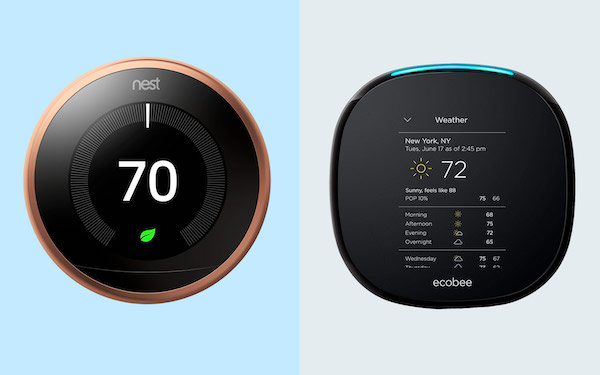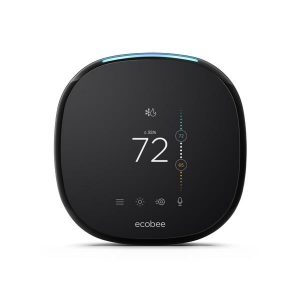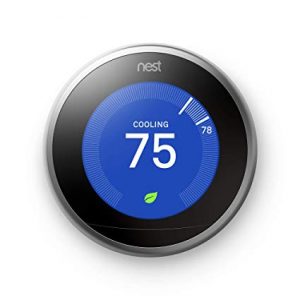Ecobee4 vs Nest: What is the Best Smart Thermostat?

Most thermostats will control temperatures based on the conditions of the room they’re in. For example, if your thermostat is placed on a wall that gets hit directly by the sun, it will operate based on that condition. This can make other rooms uncomfortable to be in.
Ecobee and Nest are two thermostat manufacturers that have come up with a solution. They make a thermostat that uses wireless remote sensors that can be placed in cold or hot rooms. Depending on the temperature there, the thermostat’s reading will change accordingly.
The two companies have two top-of-the-line models that use remote sensors. These are the Ecobee4 and the Nest Learning Thermostat. While the two function well in adjusting temperatures, they are far from being identical. This post will highlight their differences and similarities and make it easier for you to choose between the two.
Ecobee4 Features
 The Ecobee4 allows users to make programmed heating or cooling schedules and to make temperature adjustments via a smartphone app or through the thermostat itself. You can also use your voice to do the same via smart speakers or digital assistants that are found on phones.
The Ecobee4 allows users to make programmed heating or cooling schedules and to make temperature adjustments via a smartphone app or through the thermostat itself. You can also use your voice to do the same via smart speakers or digital assistants that are found on phones.
The Ecobee4 is like a smart speaker. It has Amazon Alexa built into it and is also compatible with Google Assistant, Microsoft Cortana, and Apple Siri. When you’re away for a couple of days, you can create holiday schedules that enable you to save energy.
Ecobee4 is available with a single remote temperature sensor. Its other sensors can detect occupancy. This allows it to make the temperature reading of that particular room a priority. It also takes advantage of different sensor readings to adequately cool or heat occupied rooms.
In addition to its intuitive features and controls, the Ecobee4 includes a touch-screen interface that matches that of the app. This makes it easier to make temperature changes and other adjustments easily as you switch from your device to your smartphone.
Strong sides
- The temperature of multiple rooms can be monitored using remote sensors.
- Saves up to 25% energy, making it very energy efficient.
- Easy-to-use web portal and a smartphone app that is highly functional.
- Clear and responsive thermostat screen.
- Reliable Wi-Fi and smartphone connectivity.
- Multiple and flexible cooling and heating options.
- Allows you to create reports and keep statistics.
- Thermostat settings are very variable.
- Intuitive both in its use and set up.
- Has a self-learning system.
- Sends emails or SMS when the house is below or above a certain humidity level or temperature.
- Great software support.
Weak sides
- The installation process may be difficult for someone who is not tech-savvy.
- Some functions may be difficult to set.
- Has one of the longest installation processes.
- It’s expensive. The Ecobee4 currently costs $249.
- It comes with only one sensor inside the box.
What people say
Most buyers found that having just one sensor wasn’t enough. They had to buy more sensors to maintain a balance between cooling and heating in their homes. You may have to incur the extra costs of buying more sensors.
Nest Thermostat Features
 Just like the Ecobee4, the Nest also allows users to create heating and cooling schedules and adjust temperatures from the thermostat itself or from a smartphone app. It’s compatible with digital assistants and works with Microsoft Cortana and Google Assistant. Unfortunately, it does not work with Apple Siri.
Just like the Ecobee4, the Nest also allows users to create heating and cooling schedules and adjust temperatures from the thermostat itself or from a smartphone app. It’s compatible with digital assistants and works with Microsoft Cortana and Google Assistant. Unfortunately, it does not work with Apple Siri.
Nest offers geofencing which automatically enables the device to adjust the temperature when you leave or enter the house. This is often based on the location of your smartphone. The remote temperature sensor offered by Nest is an accessory. Buyers have to part with $40 to get one.
Unlike the Ecobee4, Nest does not detect occupancy. It does not also rely on its temperature readings to balance cooling and heating. Instead, it switches between the thermostat’s temperature sensor or the remote sensor for heating and cooling. This is based on the schedule created by the user. For example, you could set the thermostat to use the bedroom sensor while you sleep then switch back to the built-in sensor in the morning.
The Nest gains an advantage over the Ecobee4 in that it uses automation and Smart IQ to operate. Thanks to smart features, it’s able to learn your behaviors and adjust the temperature accordingly.
Strong sides
The Nest comes in an attractive design. It illuminates to show the current weather conditions, an analog clock, and the set temperature. The same happens when you walk into the room.
Easy to use. The Nest features no buttons. It comes with a surrounding ring that you can turn to adjust the settings.
It’s energy-efficient and saves up to 15% of heating and cooling bills.
Nest offers additional programs and rebates for its users. You can take advantage of these to save energy and get rewards.
Thanks to geofencing, Nest is able to create a digital fence around your home.
It has a multiple-user feature that allows you and your family to use the sensors based on who is at home.
You can control the device from anywhere in the world as long as you have the app.
Weak sides
- The Nest thermostat is relatively expensive. It’s currently priced at $169.
- May require you to install a C-wire. This raises the cost of installation.
- The battery may die if there is a power outage or if you experience wiring issues.
- It has no external sensors. Getting one will cost you $40.
- The thermostat is only able to heat or cool your home within 3 degrees of your target.
What people say
The Nest has received thousands of positive reviews. However, there are buyers that have cited reliability issues. Some users complained of their Nest devices switching between Home, Stay, and Away modes causing them to sweat or freeze during the night. Others have complained about the need to teach the device your schedule for the first two weeks or so.